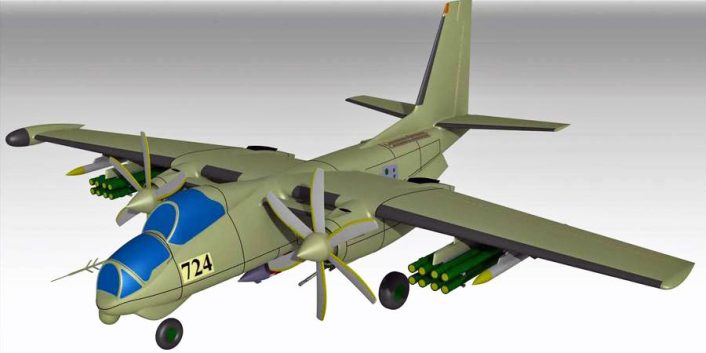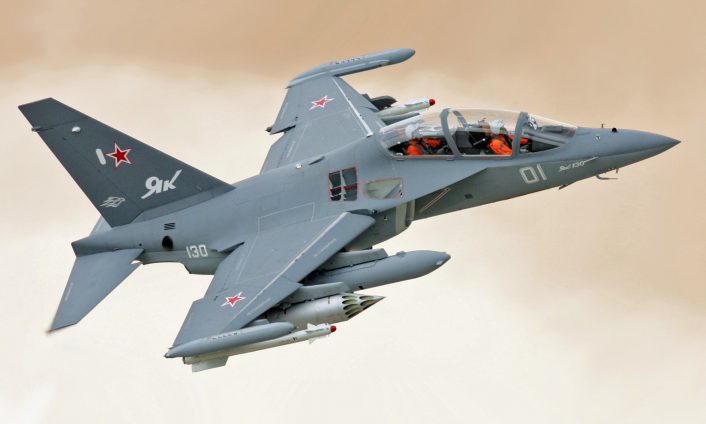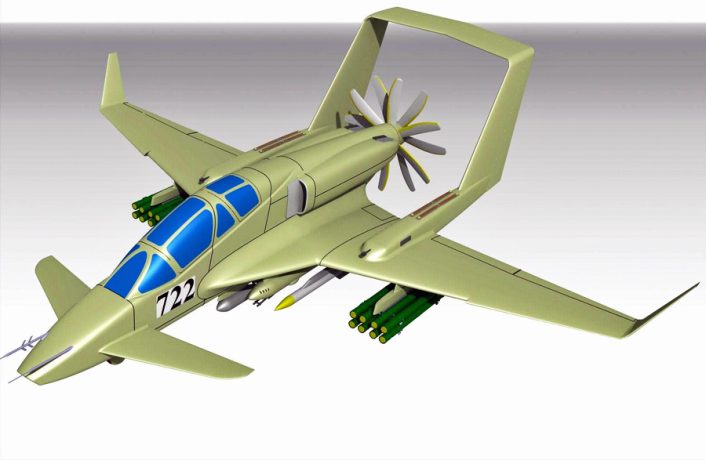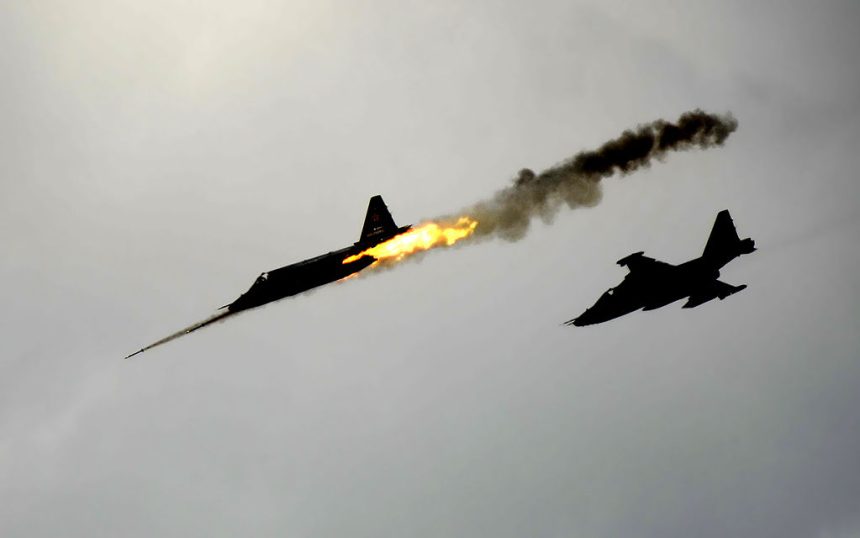Could Russia Develop A Turboprop Light Combat Aircraft? Most probably, no. But discussion brings some weird concepts to light…
An obscure Russian language news story briefly appeared in social media earlier this week that raised an interesting question: why isn’t Russia more vigorous in developing their own light attack aircraft program, especially for export? The article featuring conceptual renderings of Russian light attack concepts was published on the Russian language website “Aviator.Guru” on July 16, 2018. It was shared on the Russian aviation Facebook page “BKC России”.
The Aviation.Guru article showed renderings of what early developmental concepts for Russian manufactured light attack aircraft could look like. Although fictional, the images are interesting set against the backdrop of Russia’s involvement with anti-insurgent warfare in Syria, increasing need for defense export products and the U.S. Light Attack Experiment.

While images of Russian conceived light attack aircraft have been circulated among design schools and even aircraft manufacturers for five decades, Russia has never funded or progressed a large-scale project beyond the conceptual design/illustration phase. This seems odd, given the country’s increased emphasis on military export to countries with smaller defense budgets involved in anti-insurgent campaigns. Perhaps the trend is about to change.
Russia has been more conspicuous about very large aircraft projects, most notably the PAK-FA development that yielded the Sukhoi Su-57, a program that, as confirmed by several sources, including a July 12, 2018 report by Business Insider’s Alex Lockie, has now been scaled back considerably from full production. Russia has even teased an ambitious “PAK-DA” stealth bomber concept, even less likely to reach full-scale development than the now reportedly-struggling Su-57 program given budgetary concerns. Both these fiscally driven scale-backs seem to point the direction of Russia’s growing export tactical aircraft industry in the direction of light attack.
Light attack has been a big trend for western defense manufacturers. After ambitious progress in the U.S and operational deployment of Afghan light attack aircraft, the U.S. recently halted their ongoing Light Attack Experiment conducted largely from Holloman AFB in New Mexico. The effort was intended to evaluate not just new aircraft for the light, counter-insurgency role but also to assess new ways for the Air Force to streamline some future acquisition programs. The project was put on hold pending an investigation into a fatal accident on June 22, 2018 that claimed the life of U.S. Navy pilot Lt. Christopher Carey Short. The U.S. Air Force has said they remain dedicated the to the light attack concept.
Light attack aircraft, especially turboprops, are conspicuously absent from both Russia’s own air force and their export offerings to nation states that buy tactical aircraft from Russia. Given Russia’s involvement in the Syrian anti-insurgency and the influence of the Russian military aviation industry throughout Africa and Asia, an inexpensive, easily maintained light attack turboprop counterinsurgency aircraft that could operate from austere forward airfields could theoretically be a good seller for Russia’s growing export military aviation industry.
Russia’s current light strike capability is distributed across rotary wing assets like the Kamov Ka-50/52, Mil Mi-28 and the venerable Mi-24 Hind attack helicopters and two jet types, the successful Sukhoi Su-25, more analogous to the large U.S. A-10 Thunderbolt II, and the more modern Yakovlev Yak-130, currently employed by Russia as an advanced trainer but also suited for the light attack role.

The July 16, 2018 “Aviator.Guru” article initially discusses a need for easily maintained light attack aircraft to be used after a larger, primarily jet, air force is degraded in a large scale nuclear conflict. The article goes on to suggest, [translation]:
“If you correlate the date of the appearance of the program and the requirements for it, it becomes clear that [it is not] a post-apocalypse attack plane, but an ordinary anti-guerrilla aircraft (also COIN – a coupon-insurgency aircraft). Representatives of this class of aviation showed themselves well in Vietnam and over Latin America. No less useful they would be for the USSR in Afghanistan.”

It would appear that the renderings featured originally in the article were prepared as concepts in a design school and/or think-tank feasibility study. Portions of the study date back to the Soviet-era during the 1980s:
[Translation] “Various late versions of the LVSH [“Light Attack Experimental Program”] of the late 80’s and early 90’s: The flying prototype of the LVS never started to be built – neither in the late 80’s, nor even more so in the early 90’s. With the collapse of the Union, all the chances for the appearance of this machine in metal disappeared, but the flow of creativity could not be stopped. The models of storm troopers [aircraft concepts] surprised visitors of various exhibitions with courageous decisions – but they did not cause any interest. Too expensive, too complicated to manufacture and operate. There was no money for them in their home country.”
The translation suggests that budgetary concerns limited the former Soviet Union’s exploration of a light attack/reconnaissance/forward air control turboprop analogous to the U.S. OV-10 Bronco and A-1 Skyraider of the 1950s and 1960s.
One version of a Russian light attack aircraft did reach production though. The Khrunichev T-411 Aist or “Stork” first flew in November 1993. It is a light, high-wing utility/surveillance/light attack/counter insurgency aircraft developed by the Russian company Aeroprogress and eventually put into production by the Khrunichev State Research and Production Space Center. There was even a version sold to the civilian general aviation market in the U.S as the Aeroprogress T-411 Wolverine powered by a Continental TSIO-550-B turboprop engine. It was even offered in kit form as the Washington T-411 Wolverine. There is little information about the production numbers or outcome of the Khrunichev T-411 program, which suggests it was largely unsuccessful.
Given the legacy of some of Russia’s rugged design concepts that have made their way into aircraft like the WWII Ilyushin Il-2 Sturmovik anti-tank aircraft and the later Sukhoi Su-25, the country’s design bureaus seem uniquely qualified to produce a rugged, simple to operate, highly capable light attack aircraft. But to date, other than interesting conceptual renders and a possible increase in conversation, little appears to be happening in Russia to parallel the U.S. Light Attack Experiment. At least for the moment.
Top image credit: Eugeny Polivanov/Commons









